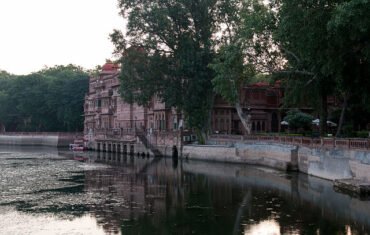If you are interested in astronomy and history, then you should visit Jantar Mantar in Ujjain. It is an observatory built by Maharaja Jai Singh II in 1725, which consists of 13 architectural astronomy instruments. It is one of the five observatories built by Maharaja Jai Singh II when he was the governor of Ujjain.
Jantar Mantar, also known as Vedh Shala, was constructed with the aim of measuring local time, altitude, and declination of the sun, stars, and planets and to determine eclipses. Motion, speed, and properties of stars and planets were also recorded using several special instruments. Jai Singh II was an astronomer and had a deep interest in science and astronomy. Visit during Ujjain Local sightseeing and one day trip from Indore and Bhopal.
He sent his scholars to various countries to study the design, construction, and technology of the observatories and also the prevalent technology. The scholars returned with their observations and many manuals on astronomy. Subsequently, between 1724 and 1737, Jai Singh II had five observatories constructed in Jaipur, Mathura, New Delhi, Ujjain, and Varanasi.
Jantar Mantar in Ujjain is located on the banks of the Shipra River, near the Gadkalika Temple. It is one of the major tourist attractions of Ujjain, which is one of the oldest and holiest cities in India. Ujjain is also known for its temples, festivals, and heritage.
Here are some details about Jantar Mantar that will help you plan your visit.
Location of Jantar Mantar-Ujjain:

Jantar Mantar is situated in Gonsa locality, about 4 km from Ujjain Junction railway station. It is easily accessible by road, rail, or air.
Timing/Entry Fees Jantar Mantar-Ujjain:
Jantar Mantar is open from 7 AM to 7 PM on all days and there is an entry fee of INR 40 per head for Indian citizens (above 15 years of age) and INR 200 per head for foreign citizens. There is also a fee of INR 50 for camera and INR 150 for audio guide.
How to reach Jantar Mantar-Ujjain:

The nearest airport to Ujjain is Indore, which is about 55 km away. You can take a taxi or a bus from Indore to Ujjain. The nearest railway station to Ujjain is Ujjain Junction, which is about 2 km away from Jantar Mantar. You can take an auto-rickshaw or a cycle-rickshaw from the station to the observatory. Alternatively, you can also drive your own vehicle or hire a car from Indore or other nearby cities.
Things to do/Must see Jantar Mantar-Ujjain:

There are many things to do and see at Jantar Mantar. Some of them are:
- Explore the observatory and learn about its history and significance. The observatory has 13 instruments such as Samrat Yantra (a giant sundial), Niyati Chakra (a wheel that shows the position of celestial bodies), Digansha Yantra (a device that measures azimuth), Shanku Yantra (a device that measures altitude), etc.
- Observe the movements and positions of the sun, stars, and planets using the instruments. You can also learn about the calculations and methods used by the ancient astronomers to study the celestial phenomena.
- Witness the audio-visual show that explains the functioning and importance of the observatory. You can also use the audio guide that provides detailed information about each instrument.
- Visit the nearby attractions such as Gadkalika Temple, which is dedicated to Goddess Kalika; Harsiddhi Temple, which is one of the 51 Shakti Peethas (powerful places of Goddess Parvati); Mahakaleshwar Temple, which is one of the 12 Jyotirlingas (self-manifested forms of Lord Shiva); and Kal Bhairav Temple, which is dedicated to the fierce form of Lord Shiva.
- Enjoy the local cuisine and culture of Ujjain. You can taste some delicious snacks such as kachori (deep-fried pastry), poha (flattened rice), jalebi (deep-fried sweet), and lassi (yogurt drink). You can also shop for some souvenirs such as religious idols, beads, rudraksha (sacred seeds), or handicrafts.
Significance of Jantar Mantar Ujjain:

Jantar Mantar in Ujjain is not only a tourist attraction but also a place of great religious and historical significance. Some of the reasons why this place is important are:
- It is associated with Maharaja Jai Singh II, who was a visionary ruler and a patron of arts and sciences. He was famous for his justice and wisdom and his stories are part of Indian folklore.
- It is one of the five observatories built by Maharaja Jai Singh II that showcase his scientific achievements and contributions to astronomy. These observatories are considered as architectural marvels and UNESCO World Heritage Sites.
- It is a place where astronomical research is still carried out using traditional methods. Several data including planetary motions are published every year from this observatory.
FAQ’s:
Q: When is the best time to visit Jantar Mantar?
A: The best time to visit Jantar Mantar is during the months of October to March when the weather is pleasant and comfortable.
Q: What are some tips for visiting Jantar Mantar?
A: Some tips for visiting Jantar Mantar are:
- Dress modestly and respectfully as this is a religious place.
- Avoid carrying valuables or expensive items as there may be crowds or pickpockets.
- Follow the rules and regulations of the observatory authorities such as maintaining cleanliness or not littering.
- Be careful while exploring the observatory as there may be sharp edges or slippery surfaces.
- Respect the sentiments and beliefs of other visitors and do not disturb them.
Conclusion:
Jantar Mantar in Ujjain is a remarkable observatory that showcases the scientific genius and legacy of Maharaja Jai Singh II. It is a place where you can learn about the ancient methods and instruments used to study astronomy and astrology. It is also a place where you can witness one of the oldest traditions of astronomical research in India. If you are looking for a fascinating and educational trip, you should definitely visit Jantar Mantar in Ujjain.










